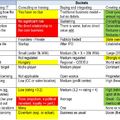“Humpty Dumpty sat on the wall, Humpty Dumpty had a great fall. All the king’s horses and all the king’s men couldn’t put Humpty together again.”

A few weeks ago, I got into a discussion with a friend of mine who doubted the validity of traditional employee satisfaction (ES) surveys. We agreed that Performance = Ability x Motivation x Opportunity to perform. In order to get there you need to let intrinsic motivation do its job. Employee Satisfaction surveys attempt to track the later two ingredients. The following blog post is focused on the question: does the old-style way of measuring ES make any sense and if not, shall we borrow a page from the book on customer loyalty measurement instead.
The known aspects of the IT labor market:
- the demand – supply equilibrium will remain a dream for the foreseeable future (one might argue that in Hungary this stands true not only for this industry).
- The lack of balance will keep increasing the cost of developers until:
- the margin you can make on a SW engineer will diminish (can a developer earn more than the CEO? J)
- an untapped supply of skilled resources shows up (eg. you move your R&D to India, not as simple as it sounds)
- growing abstraction reduces the complexity of the job, ie. a less qualified person can do it, hence the new undergraduate degree under the traditional BSc and the cross-training institutions that turn a chemistry teacher to a Java guy in a few months. BTW: who will teach chemistry in 2030?)
- an economic downturn makes the demand shrink. (as per Forrest Gump: shit happens).
A word on compensation before we talk about ES: Until the balance is achieved, regularly adjusting compensation is unavoidable, otherwise your attrition goes through the roof, and you will hire the backfills at market price (+ a risk premium) anyway. (see Herzberg's motivation-hygiene theory for the details) Painful no doubt, but not doing it will make your existing employees pay the “loyalty tax”, ie. the longer they remain at their current company the more likely that they are paid under market, so they jump.
If you pay them well already then tracking employee satisfaction becomes key since you want to know where to act. This is where companies run into the HR version of the Heisenberg uncertainty principle: the measurement itself will have an effect on the measured quantity.
- Exit interviews: this is autopsy, they may discover the reasons why folks leave, but too late. (a trailing indicator)
- Traditional employee satisfaction surveys are weird:
- HR wants to know EVERYTHING, so they come up with a 70+ question survey (considered as a book by Gen Y) – the developer gets bored after the 10th question and starts clicking her choices in a diagonal style because it looks cool or selects the super happy answer for every question just to get it done fast. (it is fun to create pivot tables on the results, but the fun goes away quickly when you realise that the questions are changed vs. last year, let alone a large portion of responders also changed.)
- After asking all these questions, excel macros collapse the whole thing into a single number and this is the only thing management will remember. (as we know from Douglas Adams: the meaning of life is 42.)
- Management is measured on the response rate, so employees get dozens of mails from various big shots instructing, (begging) to crank up this metric.
- They run it once a year (some firms every second year), create a committee (per location plus the HQ) to evaluate the results, work hard for 6 months and come up with a plan that they execute in the next 18 months. By this time 15-25% of the responders already left the original org unit (or the firm).
- They compare the data between their international sites (being thousands of miles apart with different cultures) while skip the comparison to the local labor market participants (called the competition) because “this is expensive”. (roughly the recruitment cost of two backfills.)
- They DO NOT share the results with the responders, only a stripped-down version (in pdf format) is presented to mid management. (uuh – ooh, the favourable response for question 67 went down by 4%, how embarrassing)
- The management may not genuinely interested in the responses, they do it because they have to. I recall a place in my previous life where OHI (Organisational Health Index) directly impacted any manager’s compensation. In retrospect it was a good thing, but could also be used to undermine your manager's chances for a bigger job.
- IF the management did care, they arranged small group survey evaluation sessions with their staff, where the results did become actionable, but at the expense of losing anonymity.
Here comes the ugly part: at another place in my previous life we managed to increase ES year over year, while our attrition increased. (negative correlation) Something is not right with the traditional approach. From this point on I will talk about ideas from the discussion, that I am happy to debate.
In our view employee satisfaction surveys miss the goal if:
- There is no action based on the feedback (the definition of insanity is doing the same thing over and over again and expecting a different outcome) - BAD
- The questions are wrong - I would argue that they are reasonable, just way too many (the absolute winner from my previous life went up to 300 questions, see my comment on responding in auto pilot mode.)
- The way of asking is wrong – the rest of the post will focus on this one.
And now something completely different: eNPS
Net Promoter Score is not new, online retailers have been using it for a long time to assess customer loyalty. In a nutshell NPS is a single question: “On the scale from 1 to 10 how likely it is that you would recommend this product to friend?” Answers 9-10 are supporters, 7-8 are neutral and 1-6 are detractors. NPS = (sum of supporters - sum of detractors) * 100. The focus is not only on the result but on the trends in it. Employee NPS is the same thing, but with a twist of treating the employees as if they were consumers of the “product called employment”. So it looks like this: "On a scale of 1 to 10, how likely would you be to recommend this company to a friend or colleague as a place to work?"
If you google the term eNPS, you will find hundreds of articles on it. The interesting thing is why companies do not use it already all over the place.
- Anonymity: The broad belief is that anonymity is key to get honest answers, otherwise responders would sugar coat their feedback to avoid retaliation from their management. The counter argument is that anonymity is the hotbed of whining (“Management will not know who answered, I don’t expect any change, so I ventilate a bit.”) One way to ease the concerns about retaliation is providing an opt-in, ie. the responder can disclose her identity (only a fraction of responders will choose it) if she wants OR even better if the management built a level of trust that the employees KNOW that there will be no retribution. (for the record: any decent SW developer gets a LinkedIn in-mail from a recruiter per week, so she will be gone in a month if the manager is stupid enough to retaliate.) The good news: in case of non-anonymity you will contact the responder and follow up on her reasons for a low score. Personal discussion and acting upon the feedback do miracles.
- Frequency: originally NPS was collected after every transaction. This might be an overkill for eNPS, but once per quarter, potentially as part of the All hands meeting or doing it in small chunks on a sub unit level it makes sense. It is a bit like CI/CD (Continuous Integration/Continuous Delivery) for HR.
- Complexity – the number of questions: there are multiple schools in this matter, some of them ask a clarifying question if a response is under 7, some ask the same question on the products of the company the employee works for.
FYI: it does not matter how you measure employee satisfaction if the basics are not right: ie. if the work is mundane, employees cannot see how their work corresponds to the greater goal (no intrinsic motivation), if there is no clear connection between achievement and appreciation, if there is no well-articulated company vision (start with the why) or if the line managers are a pain in the neck.
The final word: traditional employee satisfaction surveys may no longer be enough, if you want to keep your hand on the pulse of the organisation, you need something shorter, more actionable and more frequent. A viable option is eNS. Give it a try.




